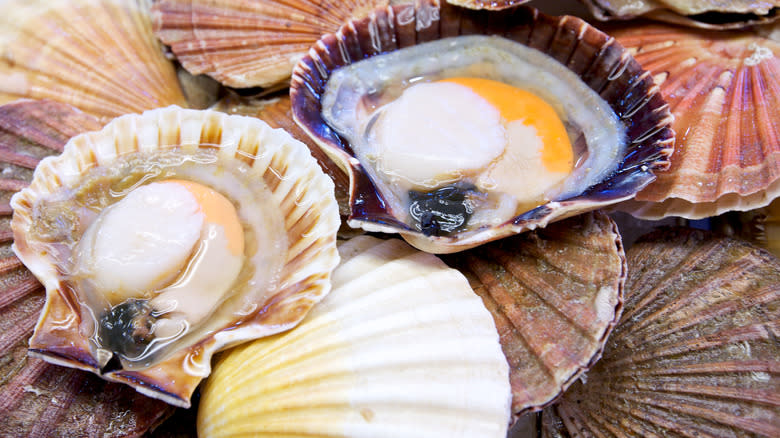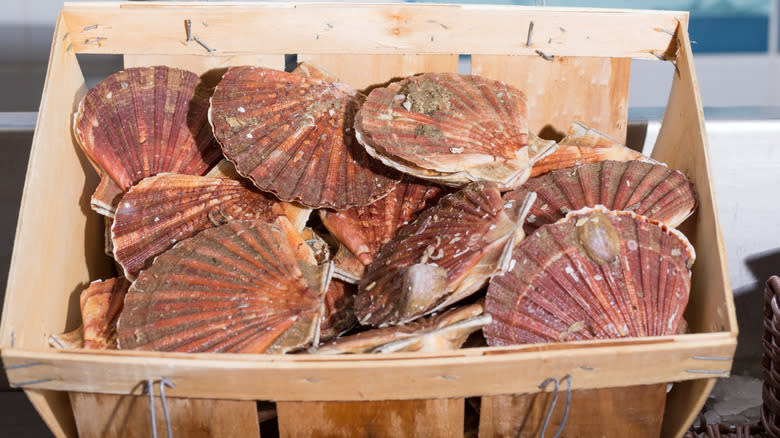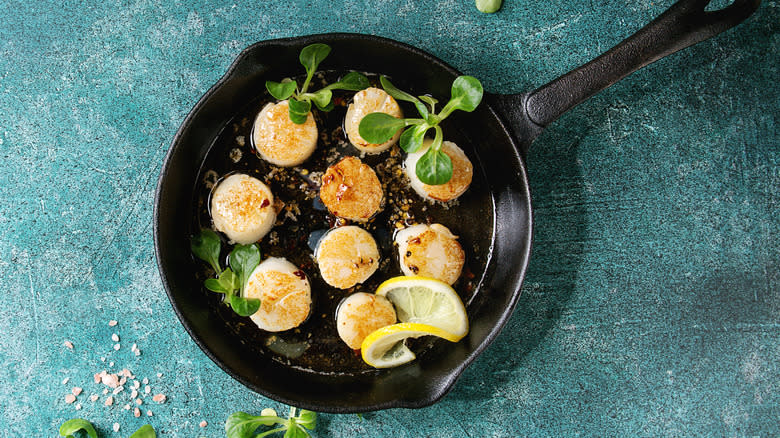The Difference Between Diver And Day Boat Scallops

Buying seafood can be mystifying. Labels like wild-caught or farm-raised, unstandardized color-codes and systems designed to indicate sustainability can all make a basic shopping trip into a head-scratching endeavor, even if you think you know exactly what you want. Within a single category, like scallops, you'll find a whole range of different varieties. One question that may arise is the difference between day-boat and diver scallops — which you may also hear referred to as "draggers" and "divers" for short. Believe it or not, the answer is exactly as you might suspect. Day-boat scallops have been harvested from a boat that "drags" or dredges for scallops along the coast within the course of a single day, while divers are literally scooped up by hand.
Given the labor intensiveness of the latter practice, these water-born gems tend to be pricier than their boat-harvested brethren, but there are arguably many benefits to further substantiate the price tag. Particularly if you're concerned about greener cuisine, the diver method is a low-intervention process that's less disruptive for the ecosystem and thus superior from an environmental perspective. From a quality perspective, diver scallops also tend to be larger than day-boat, and in better shape as the harvester can be more discerning and gentler with their selections.
In terms of timing and terroir, diving for scallops takes place between December and April during the winter season in New Hampshire and Maine, while dragging is a year-round effort in federally regulated waters.
Read more: 12 Underrated Types Of Fish You Should Try At Least Once
Diver Scallop Misinformation

Diver scallops are relatively new to the seafood world, emerging as a category in the 1980s. That's when the Portland, Maine seafood trader Rod Mitchell decided to sell his hand-harvested winter bounty under the term "diver scallops," and top chefs ate it up. They were large, fresh, and considered to be a premium product that could — and should — be distinguished from other scallops. Soon, consumers began to recognize the language and request those divers when visiting their favorite restaurants and markets. It was also appealing to those looking for more eco-friendly options at a time when awareness around environmental issues had intensified.
Then, for reasons related to a regulatory effort elsewhere in the seafood industry, there was a coincidental boom in the availability of large scallops in the early aughts. Because diver scallops had come to be associated with their size, consumer confusion set in, and pretty soon the label was being used to describe just about any scallop that was on the bigger side, without any concrete confirmation that it was harvested by hand.
Like many labels that aren't defined or enforced by a governing regulatory body, the term "diver" has been a challenge to verify, tossed out on menus as freely as similar unstandardized marketing terms like "farm-to-table." Today, it's estimated that less than 10% of scallops are hand-harvested in Maine — a statistic that indicates that the real deal is extremely rare.
Buying And Cooking Scallops

The best way to avoid misinformation is to purchase from a trusted source. It's always a good idea to form a relationship with your vendors regardless of the product, and when you visit your fishmonger, ask questions about origins, process, and source as much as possible. Bonus points if you can buy directly from a harvester.
Another question to consider when shopping for both day-boat and diver scallops is how they're "packed." All scallops are shucked immediately after harvesting, and then packed either "wet" or "dry." Dry-packed scallops are typically free of chemical preservatives, and their flavor will reflect that purity.
Regardless of whether you opt for divers or day-boats, scallops are versatile in the kitchen and can be grilled, braised, seared, fried, or baked. They also work beautifully in a scallop stir-fry, and seared scallops with basil risotto make for a substantial and impressive meal. Raw scallops can be refrigerated for one to two days and freeze well for up to a year; after cooking, they can stay in the fridge up to four days, and will keep for three months in the freezer.
Read the original article on Daily Meal.


